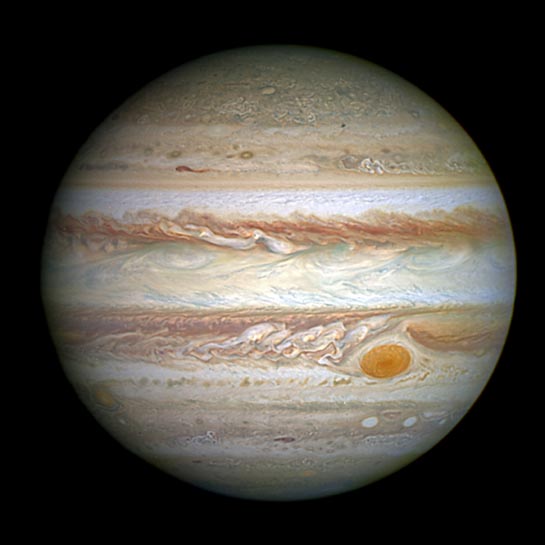
Is Smaller than Ever Seen Before
Description: Planet
Distance: The semi-major axis of Jupiter's orbit about the Sun is 5.2 astronomical units (483 million miles or 778 million km).
Dimensions: The planet has a diameter of roughly 88,789 miles (142,984 km) at the equator.
Image Credit: NASA, ESA, and A. Simon (Goddard Space Flight Center)
Release Date: May 15, 2014
ABOUT THIS IMAGE:
Jupiter's trademark Great Red Spot is a swirling anticyclonic storm feature larger than Earth.[1] It shows up in images of the giant planet as a conspicuous deep red eye embedded in swirling layers of pale yellow, orange and white. Winds inside this Jovian storm rage at immense speeds, reaching several hundreds of miles per hour. Now, observations show that it has shrunken to the smallest size ever measured. Astronomers have followed this downsizing since the 1930s.
"Recent Hubble Space Telescope observations confirm that the Great Red Spot (GRS) is now approximately 10,250 miles across, the smallest diameter we've ever measured," said Amy Simon of NASA's Goddard Space Flight Center in Greenbelt, Md. Historic observations as far back as the late 1800s gauged the GRS to be as big as 25,500 miles on its long axis, wide enough to fit three Earths comfortably side by side.[2] The NASA Voyager 1 and Voyager 2 flybys of Jupiter in 1979 measured the GRS to be 14,500 miles across.
Starting in 2012, amateur observations revealed a noticeable increase in the spot's shrinkage rate. The GRS's "waistline" is getting smaller by 580 miles per year. The shape of the GRS has changed from an oval to a circle. The cause behind the shrinking has yet to be explained.
"In our new observations it is apparent that very small eddies are feeding into the storm," said Simon. "We hypothesized that these may be responsible for the accelerated change by altering the internal dynamics and energy of the Great Red Spot."
Simon's team plans to study the motions of the small eddies and also the internal dynamics of the GRS to determine if these eddies can feed or sap momentum entering the upwelling vortex.
In the comparison images one Hubble photo was taken in 1995 when the long axis of the GRS was estimated to be 13,020 miles across. In a 2009 photo, the GRS was measured at 11,130 miles across.
Notes:
[1] The Great Red Spot is a high-pressure anticyclone. It rotates in an anti-clockwise direction in Jupiter's southern hemisphere.
[2] The Great Red Spot itself may have been mentioned in writings before the late 1800s. There are references to Jupiter's "permanent spot" dating back as far as the late 1600s, although some astronomers disagree that the permanent spot mentioned is the Great Red Spot.